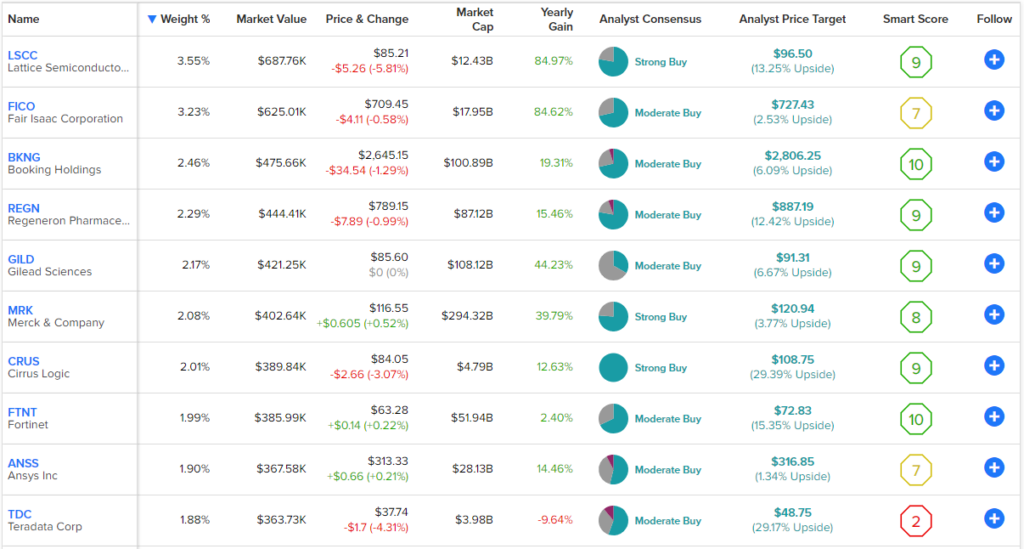The Pacer Cash Cows ETF (NYSEARCA:COWZ) has been a smash hit with investors, returning over 30% annually over the past three years and growing to $13.4 billion in assets under management in the process. This, plus the success of other similarly-themed ETFs like the Pacer US Small Cap Cash Cows 100 ETF (NYSEARCA:CALF) led Pacer to add a brand new ETF to the series, the Pacer U.S. Large Cap Cash Cows Growth Leaders ETF (NYSEARCA:COWG).
Claim 70% Off TipRanks This Holiday Season
- Unlock hedge fund-level data and powerful investing tools for smarter, sharper decisions
- Stay ahead of the market with the latest news and analysis and maximize your portfolio's potential
This newcomer to the Pacer family is similar to its counterparts but focuses on large-cap stocks within the Russell 1000 and places an emphasis on stocks with high free cash flow margins (rather than free cash flow yields, like COWZ and CALF). The COWG ETF only launched this past December, so it doesn’t have much of a track record to judge it by yet, but judging from the success of COWZ and CALF, COWG looks likely to provide solid returns for early investors.
New Cow, Different Strategy
As discussed above, COWG employs a similar strategy to the one that COWZ and CALF have used to great effect, but it tweaks it by focusing on free cash flow margin instead of free cash flow yield. Free cash flow margin is simply a company’s free cash flow divided by its revenue. It allows investors to gauge how much free cash flow a company can generate from its revenue, and it’s a good way to get an idea of the capital intensity of a company.
Pacer says that this is an effective strategy because “companies with high free cash flow margin[s] have historically generated more profitable sales.”
Big Four accounting firm Ernst & Young says that a free cash flow margin of 10%-15% is generally considered a ‘good’ free cash flow margin. However, to be clear, this is not a hard and fast rule, and comparing the free cash flow margins of stocks in different industries is not an apples-to-apples comparison.
Using this as a broad rule of thumb, however, COWG’s methodology looks interesting because after it screens for the 100 companies in the Russell 1000 with the highest free cash flow margins, its holdings have an average free cash flow margin of around 31%, so just over twice the high end of Ernst & Young’s range.
Let’s take a look at how this plays out in practice with the holdings that COWG selects.
COWG’s Holdings
COWG holds 101 positions, and its top 10 holdings account for 23.6% of holdings. Because it caps each investment at a 5% weighting, this ETF offers ample diversification. COWG’s largest holding is Lattice Semiconductor (NASDAQ:LSCC), which makes up 3.6% of assets.
Below, you’ll find a comprehensive overview of COWG’s top 10 holdings using TipRanks’ holdings tool. This screen is a one-stop shop for ETF investors, giving investors critical information like the weighting of each holding within the fund, performance, analyst ratings, analyst price ratings, and Smart Scores.
One thing that immediately jumps out about COWG is the impressive collection of Smart Scores that its top holdings possess. Lattice Semiconductor, along with Booking Holdings, Regeneron, Gilead Sciences, Merck & Company, Cirrus Logic, and Fortinet, all feature Smart Scores of 8 or better, which is equivalent to an Outperform rating.
The Smart Score is TipRanks’ proprietary quantitative stock scoring system that evaluates stocks on eight different market factors. The result is data-driven and does not require any human intervention.
This is a strong group of holdings, and one clear result of COWG’s focus on free cash flow margins instead of free cash flow yield that COWZ and CALF emphasize is that COWG skews towards different sectors. While COWZ skews heavily towards energy and healthcare, and CALF is led by consumer discretionary stocks, COWG looks a lot different.
COWG is dominated by the tech sector (or information technology, as it calls it), which makes up nearly half of the fund, with a 46.3% weighting. After that, as you may be able to guess from the positions in Regeneron, Gilead, and Merck, healthcare is the next largest sector with a weighting of 21.5%.
COWG’s emphasis on free cash flow margin has created a group of holdings more heavily weighted towards growth-oriented sectors like tech. This makes sense as these businesses are often less capital-intensive and can produce great margins.
Is COWG Stock a Buy, According to Analysts?
The analyst community is favorable towards COWG stock, assigning it a Moderate Buy rating. Further, the average COWG stock price target of $23.84 offers solid upside potential of nearly 20%. Of the 1,418 analyst price targets for COWG, 65.51% are Buys, 30.54% are Holds, and just 3.95% are Sells.
TipRanks uses proprietary technology to compile analyst forecasts and price targets for ETFs based on a combination of the individual performances of the underlying assets. Further, TipRanks calculates a weighted average based on the combination of all the ETF’s holdings. The average price forecast for an ETF is calculated by multiplying each individual holding’s price target by its weighting within the ETF and adding them all up.
Investor Takeaway
Like COWZ, COWG offers an 0.49% expense ratio, which is slightly lower than the 0.59% expense ratio of CALF. We don’t have much of a track record to judge COWG yet, but its counterparts like CALF and COWZ have given investors great returns over the past three years through a volatile market environment.
COWG is similar to these ETFs but slightly tweaks its strategy, giving it more exposure to higher-growth sectors of the economy like tech. The tech sector has been through ups and downs in recent years as interest rates increased, causing high-multiple tech stocks or those with no earnings to sell off dramatically. However, what I like about COWG is that its emphasis on free cash flow ensures that the tech companies it owns are high-quality businesses with strong free cash flow and profitability.
For these reasons, I like the idea of holding COWG in addition to COWZ and/or CALF. This enables investors to take advantage of their strong performance and effective value-oriented strategy while mixing in a bit more growth potential with COWG.



















